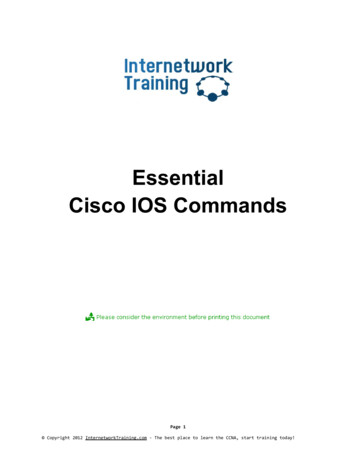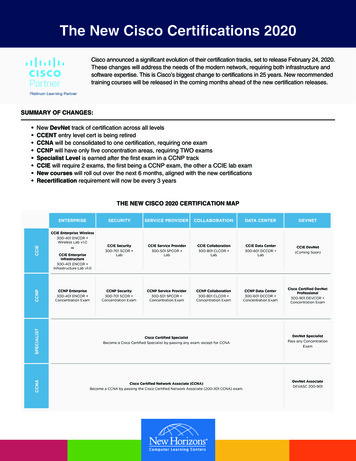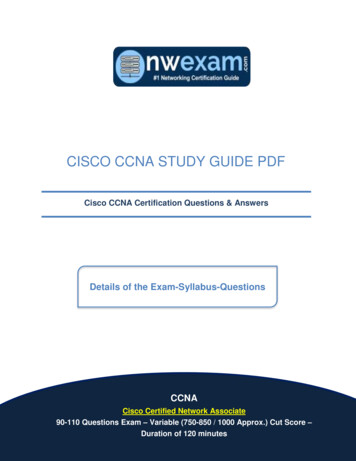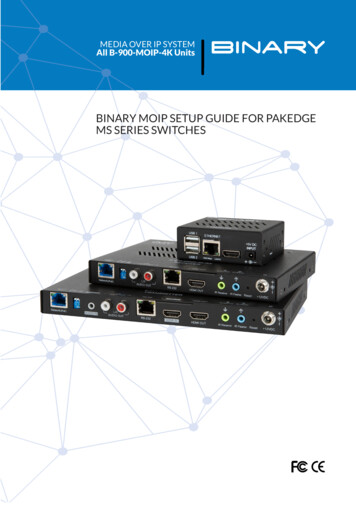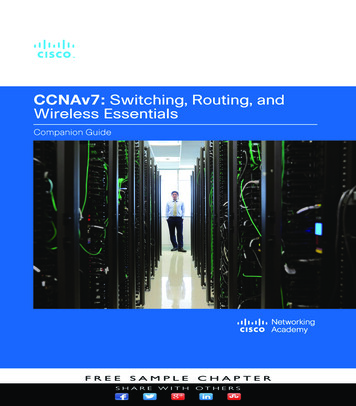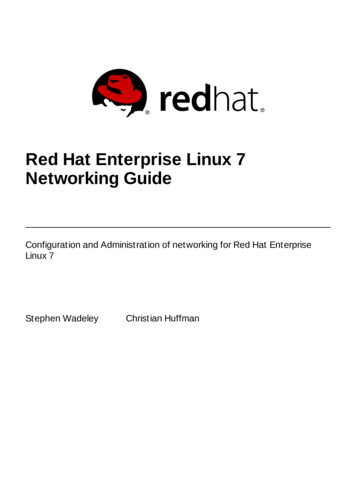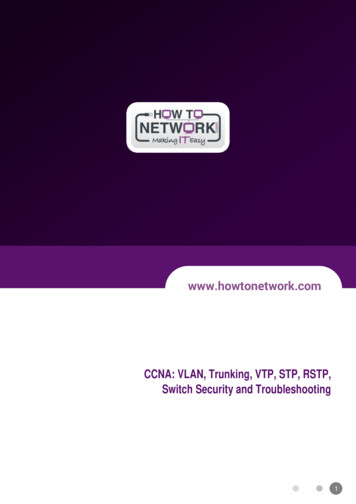
Transcription
www.howtonetwork.comCCNA: VLAN, Trunking, VTP, STP, RSTP,Switch Security and Troubleshooting11
CCNA: VLAN, Trunking, VTP, STP, RSTP,Switch Security and TroubleshootingBasic TermsCollision Domain: defines a set of interfaces whose frames could collide with each otherBroadcast Domain: defines a set of devices, whose frames are received by every device on the network when anyone of them sends trafficVirtual LANs (VLANS)VLAN allows segmentation of a switch into multiple broadcast domains. Without VLANs, a switch can only functionin a single broadcast domain. Due to the segmentation, VLANs offer the following advantages: Ease of administration Confinement of broadcast domains SecurityVLAN TrunkingTrunks allow carrying traffic for more than one VLAN on the same link. There are two types of trunks supported onCisco switches:1. Inter Switch Link (ISL): encapsulated original frame into 30-bytes ISL frame (26-bytes for ISL and 4-bytes for CRC).Cisco propriety method2. IEEE 802.1Q: an open standard. Instead of encapsulating it embeds tag 4-bytes in the Ethernet frame. Alsosupports native VLANVLAN Trunking Protocol (VTP)VTP manages the addition, deletion and renaming of VLANs across the network from central point of controlVTP Domains: VTP is organized into management domains or areas with common VLAN requirements A switch can belong to only one VTP domain Switches in different domains don’t share the VTP informationVTP Modes: Server, Client and TransparentServer: can create, delete, modify and advertise VLAN informationTransparent: can create, delete and modify VLAN information but does not advertise Client: cannot delete, add ormodify VLAN information. Accepts and advertise VTP updatesVTP switches uses an index called VTP Configuration Revision number VTP revision always starts from Zero Incremented before an advertisement is sent out Is over-written if a higher revision number advertisement is received (either by VTP client or server) Stored in NVRAM therefore cannot be alteredVTP advertisement can be secured with MD5 authenticationSpanning Tree Protocol (STP) TermsBridging Loop: formed due to redundant paths in the network. These redundant paths cause the broadcast traffic toloop around indefinitely causing what is known as the broadcast storm.Bridge ID: is an 8-byte field. Consists of bridge priority (2-byte) and MAC-address (6-byte). The bridge ID is nowextended to include the VLAN ID to avoid un-necessary consumption of MAC-addressesBridge Protocol Data Units (BPDU): STP uses special frames called BPDUs to pass STP information. Two types1. Configuration BPDU: Used for STP computation2. Topology Change Notification (TCN) BPDU: Used to announce changes in the network topologyRoot Bridge: A reference point for all bridges in networkRoot Port: One port for each nonroot switch that always points to the current root bridge. Designated Port: One portfor each segmentBlocking Port: A port that is neither a root port nor a designated port.2
CCNA: VLAN, Trunking, VTP, STP, RSTP,Switch Security and TroubleshootingSTP ConvergenceDefined in IEEE 802.1 D standard. Used to avoid bridging loops. STP convergence takes place in three steps:1.Elect the Root Bridge: the root bridge is selected with the lowest bridge ID. Essentially switch with lowest priority becomes the root. If thebridge priorities are equal, switch with lowest MAC-address becomes the rootElect the Root Port: each non-root switch must select one Root Port. The root port is a port with least Root Path Cost (cumulative cost of alllinks leading to the root bridge).Elect the Designated Port: for each LAN segment, a designated port is selected. It is responsible to forward traffic to and from that segment.A port is selected as designated when it has the least cumulative root path cost among all ports on segment.2.3.STP Port StatesThere are five port states:1.2.3.4.5.Disabled Ports that are administratively shutdown by the network administrator or not enabled due to some error.Blocking A port after initialization, begins in Blocking state to avoid bridging loops The port is not allowed to send or receive traffic and only allowed to receive STP Ports that are put in standby mode to remove bridging loops after STP computation enter blocking stateListening A port is moved from blocking to listening if the switch thinks that the port can be selected as Root Port orDesignated Port Still cannot send and receive traffic but is now allowed to send BPDUs inaddition to receiving them. In this state the port is allowed to become Root Port or designated port because the switch can advertise the port by sendingBPDUs to other switches If a port losses it status as Root Port or Designated port it is put in blocking stateLearning After a period of time called FORWARD DELAY (15 seconds)u in listening state, the port is allowed to move in learning state Port can send and receive BPDUs Port can learn and add MAC addresses to CAM table which previously was not allowed. Port cannot send and receive any data framesForwarding After another FORWARD DELAY in learning state, the port is moved into forwarding state Port can send and receive BPDUs Port can learn MAC addresses Port can send and receive data frames Port can only be in forwarding if there is no loop and it is either designated port or root portSTP Timers1.Hello Time 2.Forward Delay 3.It is the time interval between Configuration BPDUs sent by root bridgeThe default time is 2-secondsIt is the time interval configured on Root Bridge. All non-root bridges adapt the root bridge hello time intervalSwitches also have a locally configured Hello time that is used for Topology Change Notification (TCN)The time interval that a switch port spends in the Listening state and the Learning stateThe default time is 15 secondsMax (maximum) Age The time interval that a switch stores the BDPU before aging it outThe default value is 20 secondsSTP Path Selection CriteriaIf a bridge receives multiple BDPUs with equal parameters, the following are used as a tie breakers for path selection:1. Lowest Root Bridge ID2. Lowest Root Path Cost to root bridge3. Lowest Sender (neighbor) Bridge ID4. Lowest Sender Port ID3
CCNA: VLAN, Trunking, VTP, STP, RSTP,Switch Security and TroubleshootingSTP EnhancementsPort Fast: usually enabled on port that connects to server or end user workstation. It allows the port to transitionimmediately to the forwarding state bypassing the forward delays in listening and learning states.Uplink Fast: used to speed up convergence time when direct failure of a root port. If the Root Port fails, the Port with thenext-lowest Root-Path Cost is unblocked and used without any delay. Used on access-layer switchesBackbone Fast: Optimizes convergence when an Indirect link failure occurs. Allows convergence to be reduced from 50 secondsto 30 seconds when an indirect link failure occurs. Used to determine if there are alternative paths to the Root Bridge. Shouldbe enabled on all switches to allow the propagation of link failures throughout the network. Switches detect indirect topologychanges when inferior BPDU is detected. Detection of alternative path is done with Root Link Query (RLQ) protocolProtecting the STP Topology: Unexpected BPDUsRoot Guard: When enabled on an Interface, it ignores any received superior BPDUs to prevent switch connected to this port tobecome Root Bridge. The port receiving the new superior BPDU is put in ROOT-INCONSISTENT state ceasing forwarding andreceiving of frames until the superior BPDUs cease. When the superior BPDUs are no longer received, the port is cycled throughthe normal STP states to return to normal use.BPDU Guard: it is enabled on ports with PortFast. If a BPDU is received, the port is put in ERRDISABLE state. The port then mustmanually shut/no shut or automatically recovered with ERRDISABLE timeout function. Can be enabled globally or per-interfacebasisProtecting STP Topology: Unexpected Loss of BPDUsLoop Guard: It Keeps track of BPDU activity on non designated Ports. While BPDUs are received the port is allowed to behavenormally. If there is loss of BPDUs, the Port is moved into Loop-inconsistent State. When LoopGuard is not enabled on a blockingport and there is sudden loss of BPDUs that port is transitioned through STP states and put into forwarding which may causeloops.UDLD: UDLD interactively monitors a port to see if the link is truly bidirectional. Unidirectional links result in loss of BPDUson a port that may transition to forwarding state from blocking stateRapid Spanning Tree Protocol (RSTP)IEEE defined an improved version of STP in standard 802.1s. Procedures inherited from traditional STP include:1. Election of Root Bridge and same tie-breaking criteria2. Election of Root Port on Non-Root with the same rules3. Election of Designated PortRSTP Port RolesRoot Port: with best root path cost to root bridgeDesignated Port: with best root path cost to root on the segmentAlternative Port: provides alternative path less desirable then root port. Alternative/backup to root portBackup Port: provides a redundant but less desirable connection to a segmentRSTP Port StatesRSTP defines port states according to what port does with incoming frame. If incoming frames are ignored ordropped, so are outgoing frames1.2.3.Discarding Incoming frames are dropped No MAC addresses are learned This state combines 802.1D Disabled, Blocking and Listening statesLearning Incoming frames are dropped but MAC addresses are learnedForwarding Incoming frames are forwarded according to CAM table4
CCNA: VLAN, Trunking, VTP, STP, RSTP,Switch Security and TroubleshootingRSTP Port Types and Convergence1. Edge Similar to PortFast featurePorts connecting to end-usersPorts in edge mode are immediately put in forwarding stateIf an edge port receives a BPDU, it loses2. Root The port that has best cost to the root. Only one root port can be selected and active at any timeAlternative root ports can exists but will only be active if the primary root port fails3. Point-to-Point (P2P) Any port that connects to another switch and becomes a designated port. A quick handshake with theneighboring switch rather than a timer expiration decides the port state. BPDUs are exchanged back and forth in the form of a proposal and an agreement One switch port proposes to become designated and if other switch agrees it replies with an agreement message Point-to-Point ports are determined with duplex setting Full duplex port are considered P2P because only two-switches can be present on the link RSTP convergence occurs quickly with handshake message4. Shared Half duplex port is considered shared medium with possibly more than two switches present Traditional STP style convergence takes place on shared mediumSwitch SecurityThe following securitys method are support on Cisco Catalyst switches1. Access Control List: Cisco IOS Switches support Standard and Extended ACLs and Named ACLs. In addition, Named MAC ACLsare also supported to filter traffic based on layer-2 addresses. Named MAC ACLs also support filtering of Non-IP traffic2. IEEE 802.1X Port Based Authentication: allows client-server based access control authentication. Prevents un-authorizedaccess to network unless properly authenticated. Until the client is authentication only CDP, STP and ExtensibleAuthentication Protocol over LAN (EAPoL) is allowed to pass through the specified port3. Port Security: allows only specified number of MAC-address to access the port. MAC addresses must be defined or could belearned when the client is first connected to the port. If a port security violation occurs, one of the following three actioncan be configured: Protect: traffic from unknown MAC-address is dropped and no notification is generatedPort can send andreceive BPDUs Restrict: traffic from unknown MAC-address is dropped and notification is generated. Usually an SNMP trap isgeneratedPort can send and receive data frames Shutdown: the port is transited to ERROR-DISABLED state and the port is shutdown. An SNMP trap or syslog message isalso generated. A port can be recovered from ERROR-DISABLED by either configuring: “errdisable recovery cause”command or manually applying “shutdown” and “no shutdown” command to the interfaceConfiguration Example: Creating VLANsconfigure terminal1. configure termvlan vlan-id 2. vlan 100name name 3. name Salesinterface int-id 4. interface fastethernet 0/1switchport mode access5. switchport mode accessswitchport access vlan vlan-id 6. switchport acces vlan 100end7. endVLANs can also be created directly by applying the “switchport access vlan vlan-id ” command to an interfaceThe “switchport mode access” command statically configures the port in access modeVerification and Troubleshooting1.2.3.4.5.6.7.1.2.3.show vlan briefshow switchport interface int-id show running-configuration5
CCNA: VLAN, Trunking, VTP, STP, RSTP,Switch Security and TroubleshootingConfiguration Example: Trunkingconfigure terminalinterface int-id switchport trunk encapsulation isl dot1q negotiate switchport mode trunk dynamic desirable dynamic auto switchport nonnegotiateThe “switchport nonegotiate” command disables the negotiation of trunking between the pair of switches. Usually usedon interface that connect to routers as they don’t support the dynamic trunking protocol1.2.3.4.5.Tunking Mode: Trunk: Always trunking Dynamic Desirable: Initiates negotiating messages and respond to negotiation messages (active mode) Dynamic Auto: Only respond to negotiation messages (passive mode)Switch SW-1:1. configure terminal2. vlan 1003. names Sales4. interface range fastethernet 0/1 - 155. switchport mode access6. switchport acces vlan 1007. interface gigabitethernet 0/08. switchport trunk encapsulation dot1q9. switchport mode trunkVerification and Troubleshooting1. show vlan brief2. show interface status3. show interfaces trunkConfiguration Example: VTP1. configure terminal2. vtp mode server client transparent 3. vtp domain name 4. vtp version 1 2 5. vtp password value 6. vtp pruning7. endSwitch SW-1:1. configure terminal2. vlan 100,200,300,400,500,6003. vtp mode server4. vtp domain CCNA5. vtp version 26. vtp password ccna-lab7. vtp pruning8. endDIAGRAM # 1Switch SW-2:1. configure terminal2. vlan 1003. names Sales4. interface range fastethernet 0/1 - 155. switchport mode access6. switchport acces vlan 1007. interface gigabitethernet 0/08. switchport trunk encapsulation dot1q9. switchport mode dynamic desirableSwitch SW-2:1. configure terminal2. vtp mode client3. vtp domain CCNA4. vtp version 25. vtp password ccna-lab6. End6
CCNA: VLAN, Trunking, VTP, STP, RSTP,Switch Security and TroubleshootingVerification and Troubleshooting: VTPSW2# show vtp statusVTP Version2Configuration Revision8Maximum VLANs supported locally36Number of existing VLANs11VTP Operating Mode: ClientVTP Domain Name: CCNAVTP Pruning Mode: EnabledVTP V2 Mode: EnabledVTP Traps Generation: DisabledMD5 digest: 0xFD 0x93 0x2B 0xB2 0x8F 0x46 0xFD 0xC3Configuration last modified by 10.1.1.1 at 3-1-02 00:06:17When MD5 is configured, the digest should be same on both switchesThe number of VLAN in “show vlan brief” should be equal to VLANs configured on VTP serverConfiguration Example: STP and RSTP1. spanning-tree vlan vlan-id root [primary secondary] diameter value hello-time value 2. spanning-tree vlan vlan-id priority value makes a switch to become root for specified vlan priority range is 0 to 61440 and increments with a value of 40943. spanning-tree vlan vlan-id hello-time value 4. spanning-tree vlan vlan-id forward-time value 5. spanning-tree vlan vlan-id max-age value 6. spanning-tree mode [pvst mst rapid-pvst]7. interface interface-id 8. spanning-tree link-type [point-to-point] Related to Rapid-PVST9. spanning-tree [vlan vlan-id ] port-priority value 10. spanning-tree [vlan vlan-id ] cost value 1. show spanning-tree vlan vlan-id 2. show spanning-tree summary3. show spanning-tree interface interface-id 4. show spanning-tree detail detail summary of interfaces5. show spanning-tree active stp on active interfaces6. show spanning-tree summary [totals]For diagram # 1, let us consider the following scenario:1. SW2 should be the Root Bridge for VLAN 100 and SW is the backup root2. SW 1 should be root for VLAN 200.3. The hello and forward delay times should be 5 and 25 seconds respectively for VLAN 100Switch SW-1:Switch SW-2:1. configure terminal1. configure terminal2. spanning-tree vlan 100 root secondary2. spanning-tree vlan 100 root primary3. spanning-tree vlan 200 priority 40963. spanning-tree vlan 100 hello-time 54. spanning-tree vlan 100 forward-time 25Verification and Troubleshooting: STPSW1#show spanning-tree vl 100 rootRoot ID Priority 4096Address c204.0e00.0001This bridge is the rootHello Time 2 sec Max Age 20 sec Forward Delay 15 sec7
CCNA: VLAN, Trunking, VTP, STP, RSTP,Switch Security and TroubleshootingVerification and Troubleshooting: STPSW2#show spanning-tree vlan 100 briefVLAN100Spanning tree enabled protocol ieeeRoot ID Priority 8192Address c205.0e00.0001This bridge is the rootHello Time 2 sec Max Age 20 sec Forward Delay 15 secBridge ID Priority 8192Address c205.0e00.0001Hello Time 5 sec Max Age 20 sec Forward Delay 25 secAging Time 300InterfaceNamePort DDesignatedCost000Bridge ID8192 c205.0e00.00018192 c205.0e00.00018192 c205.0e00.0001Port ID128.42128.43128.53SW2#Configuration and Troubleshooting: Port Security1. interface int-id 2. switchport mode access3. swithcport security4. swithcport security maximum max-mac-addresses-value 5. swithcport security mac-address [ mac-address sticky]6. switchport port-security violation {protect restrict shutdown}1. show port-security2. show port-security [interface int-id ]3. show port-security addressSW1# show port-securitySecure 1/111Fa1/221Total Addresses in System: 21Max Addresses limit in System: 128SW1# show port-security interface fastethernet 1/1Port Security: Enabled Portstatus: SecureUp Violationmode: ShutdownMaximum MAC Addresses: 1Total MAC Addresses: 1Configured MAC Addresses: 1Aging time: 20 minsAging type: InactivitySecureStatic address aging: EnabledSecurity Violation count: t8
CCNA: VLAN, Trunking, VTP, STP, RSTP, Switch Security and Troubleshooting STP Enhancements Port Fast: usually enabled on port that connects to server or end user workstation. It allows the port to transition immediately to the forwarding state bypas
